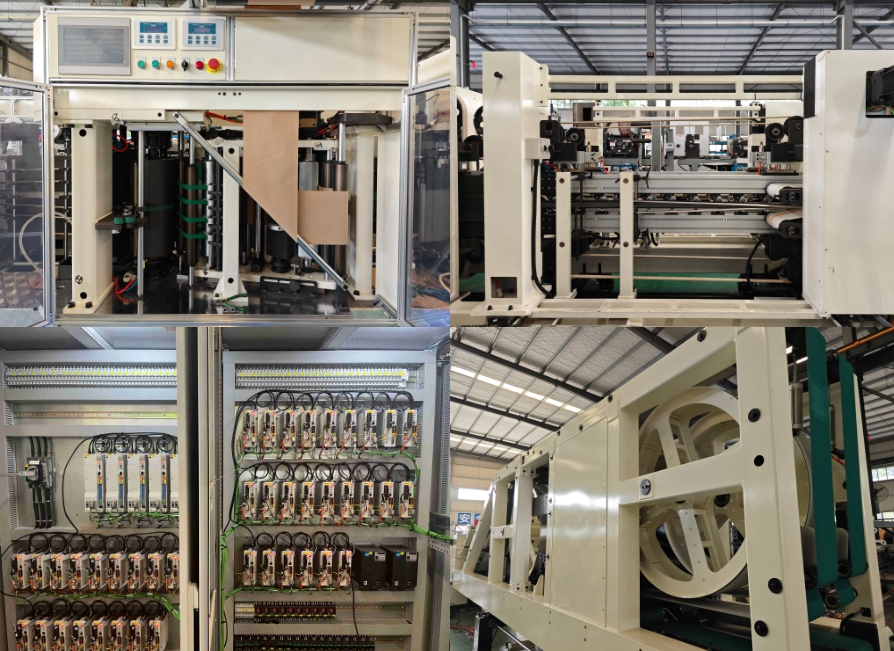Factors to Consider When Choosing a Bottomer Machine
Bottomer machines are essential for producing valve bags, used across various industries such as cement, chemicals, and food production. These machines automate the process of sealing the bottom of the bags, enhancing production efficiency and ensuring consistent product quality. However, selecting the right bottomer machine is crucial for manufacturers aiming to maximize output while maintaining cost-effectiveness and high-quality standards.
High Speed Bottomer Machine GU8320
When choosing a bottomer machine, several factors come into play, including the machine’s compatibility with different materials, production speed, precision, and ease of maintenance. This article outlines the key considerations manufacturers should evaluate to make an informed decision.
1. Material Compatibility
One of the most important factors to consider is the machine’s compatibility with the materials used to produce valve bags. Bottomer machines are typically designed to handle specific materials such as kraft paper, plastic, woven polypropylene, or even biodegradable materials. Manufacturers need to ensure that the chosen machine can process the material they use or plan to use in the future. Some machines are more adaptable and can work with multiple materials, providing greater flexibility in meeting customer or market demands.
2. Production Speed and Capacity
The production speed of a bottomer machine is critical, particularly for manufacturers with high-volume production requirements. The speed of the machine affects overall output and, ultimately, the company’s ability to meet customer demand.
When evaluating production speed, consider:
● The number of bags the machine can produce per hour.
● How easily it can handle changes in bag size or material type.
● The amount of downtime required for maintenance or material changes.
A machine with high throughput will boost productivity, reduce bottlenecks, and ensure that the production line operates at peak efficiency. However, it’s also important to ensure that speed does not come at the expense of product quality.
3. Precision and Consistency
Precision is another key factor, especially when it comes to sealing the bottom of valve bags. Inconsistent or faulty seals can lead to leaks, contamination, or structural failures during transport and storage. This not only results in product waste but can also damage a manufacturer’s reputation for quality.
The right bottomer machine will provide consistent, high-quality sealing, reducing the risk of defective bags. Machines equipped with advanced sensors, automation, and real-time monitoring capabilities offer better control over the sealing process. Precision minimizes material waste and improves product consistency, ensuring that every bag produced meets the required standards.
4. Ease of Maintenance and Operation
A machine's ease of use and maintenance are often overlooked but are essential considerations. Complex machinery that requires specialized training for operation or frequent maintenance can slow down production and increase costs.
Look for a bottomer machine with:
● User-friendly interfaces, allowing operators to make adjustments easily.
● Automated features, such as self-diagnosing capabilities or maintenance alerts, to reduce downtime.
● Quick-change settings for adjusting bag sizes or material types without halting production for long periods.
Additionally, ensure that spare parts for the machine are readily available and that the manufacturer offers strong technical support. Machines that are easy to operate and maintain contribute to fewer interruptions in production and lower long-term operating costs.
5. Automation and Integration Capabilities
Modern bottomer machines often come with advanced automation features that enhance efficiency by reducing the need for manual intervention. Consider a machine that offers seamless integration with your existing production line, including printing, cutting, and filling equipment.
Automation ensures smooth operation and reduces errors while boosting productivity. Machines with programmable logic controllers (PLCs), smart sensors, and integration capabilities with other equipment can optimize production, offering a fully automated solution that minimizes human error and downtime.
6. Customization and Flexibility
Some manufacturers have varying requirements for valve bags, depending on the type of product being packaged. Flexibility is key when choosing a bottomer machine, as it should be able to accommodate different bag sizes, types, and sealing methods.
Consider whether the machine allows for:
● Adjustments in bag size and shape.
● Different sealing methods (e.g., gluing, heat sealing, stitching).
● The ability to switch between different materials efficiently.
A machine that can easily adapt to different product requirements ensures that your production line remains agile and responsive to market demands.
7. Energy Efficiency
With sustainability becoming increasingly important in modern manufacturing, energy efficiency is a crucial factor when selecting a bottomer machine. Machines that consume less energy help reduce operational costs and minimize the environmental impact of production.
Look for energy-saving features such as:
● Optimized power usage without compromising production speed or quality.
● Eco-friendly material handling, allowing you to use sustainable materials like recyclable paper or biodegradable plastics.
Investing in an energy-efficient machine not only helps lower your carbon footprint but also offers long-term savings on operational costs.
8. Initial Investment and Long-term Costs
Finally, manufacturers must consider both the initial investment and the long-term operational costs of a bottomer machine. While cheaper machines may seem attractive upfront, they may lack the durability, automation features, or precision needed for long-term efficiency.
Evaluate:
● The upfront cost of the machine.
● Expected maintenance and operational expenses.
● Energy consumption and potential savings.
● The machine’s lifespan and return on investment (ROI).
A more expensive but reliable and efficient machine can provide better long-term value by reducing maintenance costs, boosting productivity, and lowering energy bills.

Full Servo System Bottomer Machine
Conclusion
Choosing the right bottomer machine is a critical decision that can significantly impact your production efficiency, product quality, and overall profitability. By considering factors such as material compatibility, production speed, precision, ease of maintenance, and energy efficiency, manufacturers can select a machine that aligns with their specific needs and operational goals. Investing in a well-chosen bottomer machine will enhance productivity, reduce waste, and contribute to a more sustainable and cost-effective manufacturing process.
